Management Accounting Report: RH Amar Analysis and Strategies
VerifiedAdded on 2021/02/20
|16
|4318
|36
Report
AI Summary
This report examines the application of management accounting principles within the context of RH Amar, a food import and distribution company. It covers essential elements of management accounting, including data collection, analysis, and decision-making processes. The report details various management accounting systems, such as financial, cost, and tax accounting, along with different reporting methods like performance reports, inventory management reports, cash flow statements, and balance sheets. It further explores costing techniques through marginal and absorption costing methods, including the preparation of cost cards and profit and loss statements for different months. Finally, the report discusses the advantages and disadvantages of planning tools like zero-based budgeting and provides an overview of how management accounting systems support the resolution of financial problems within a business context.
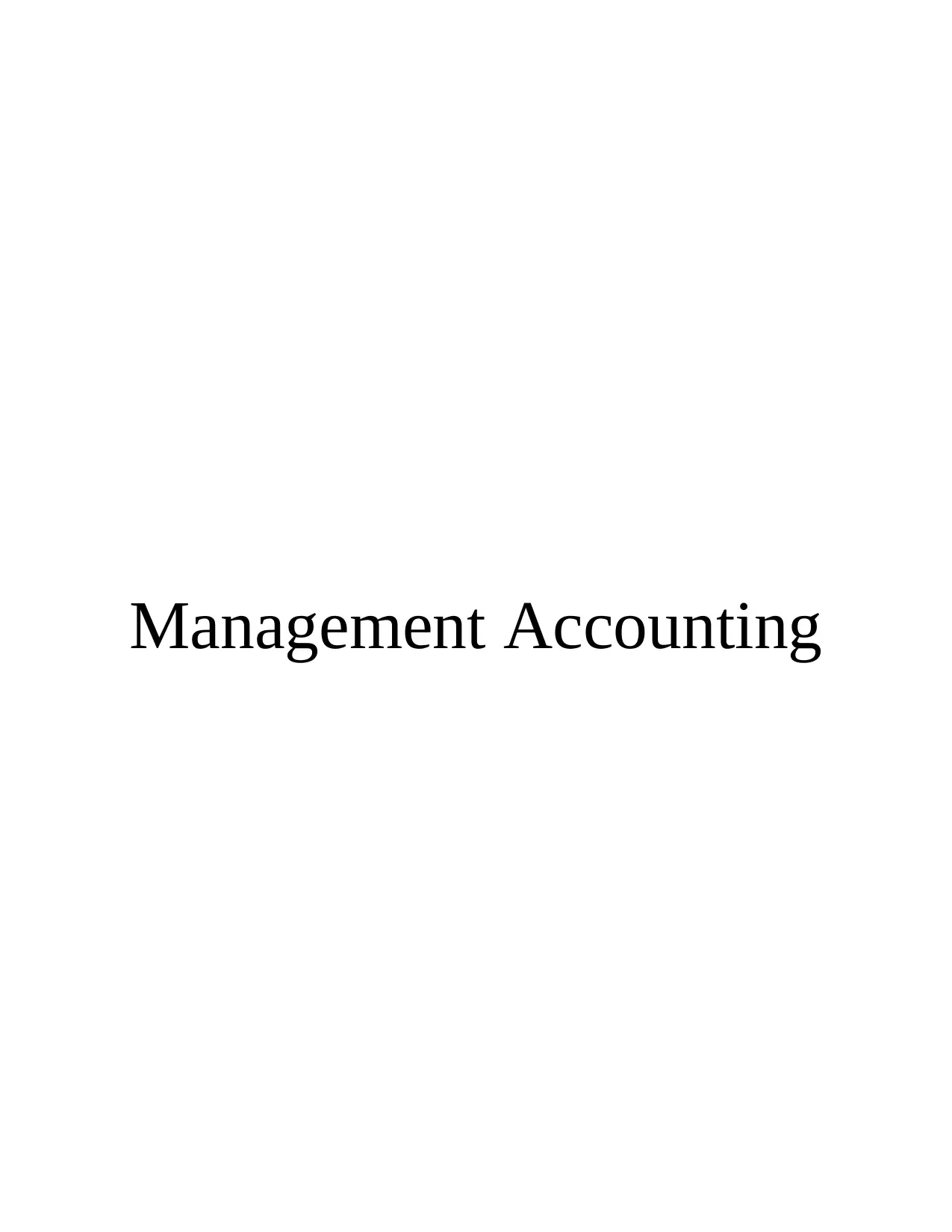
Management Accounting
Paraphrase This Document
Need a fresh take? Get an instant paraphrase of this document with our AI Paraphraser
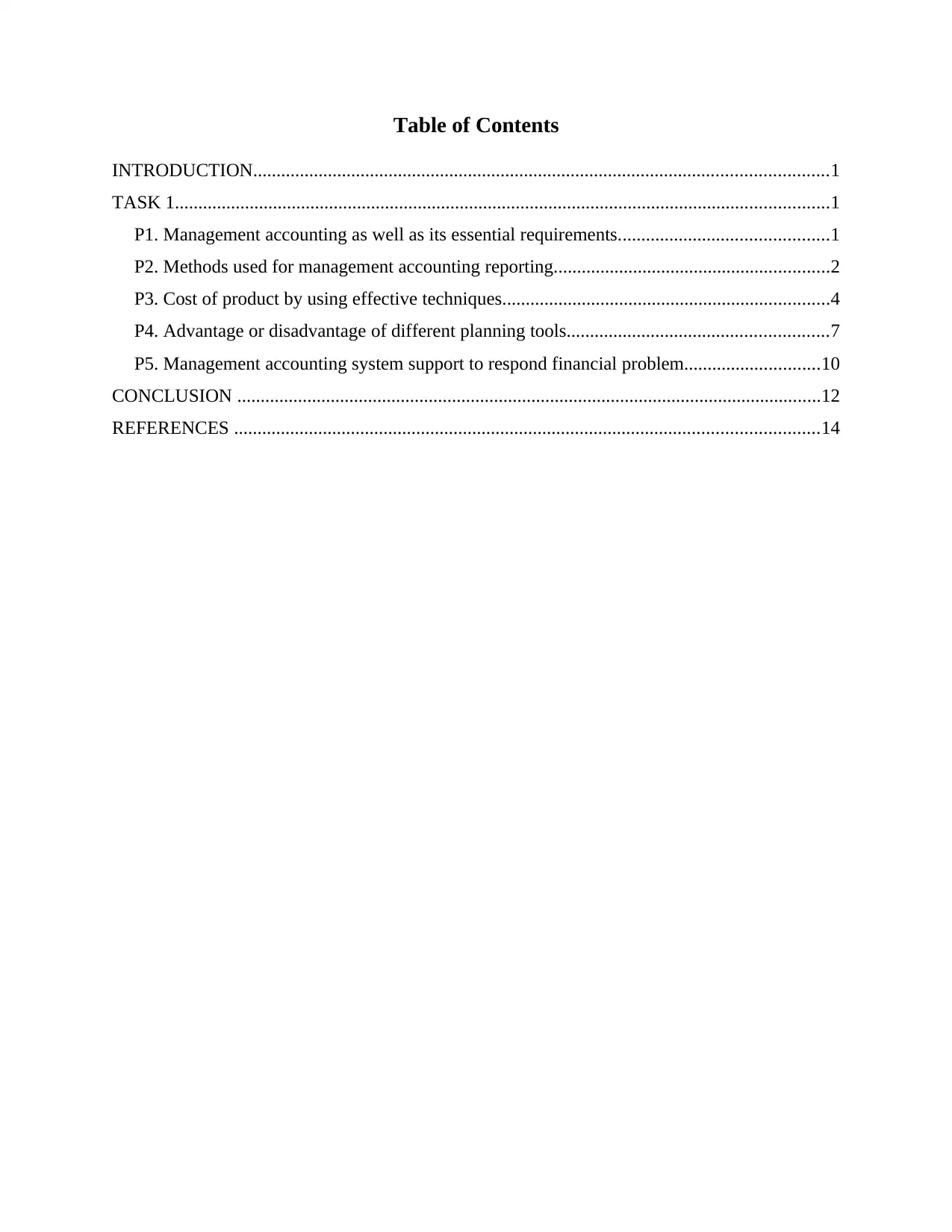
Table of Contents
INTRODUCTION...........................................................................................................................1
TASK 1............................................................................................................................................1
P1. Management accounting as well as its essential requirements.............................................1
P2. Methods used for management accounting reporting...........................................................2
P3. Cost of product by using effective techniques......................................................................4
P4. Advantage or disadvantage of different planning tools........................................................7
P5. Management accounting system support to respond financial problem.............................10
CONCLUSION .............................................................................................................................12
REFERENCES .............................................................................................................................14
INTRODUCTION...........................................................................................................................1
TASK 1............................................................................................................................................1
P1. Management accounting as well as its essential requirements.............................................1
P2. Methods used for management accounting reporting...........................................................2
P3. Cost of product by using effective techniques......................................................................4
P4. Advantage or disadvantage of different planning tools........................................................7
P5. Management accounting system support to respond financial problem.............................10
CONCLUSION .............................................................................................................................12
REFERENCES .............................................................................................................................14

INTRODUCTION
Management accounting provides sufficient advantages like monitoring day-to-day
operations, analysing data and writing financial statements with the support of everything
collected related to operations (Arunruangsirilert and Chonglerttham, 2017). Manager need detail
and cosine information about each and every business activity that enables them to make better
decision for improving the overall productivity and profit margins. In this report, RH Amar have
been selected that helps to better understand the importance of management accounting. The
company use to import and distribute food item for each and every type of customer such baby
food, capers, Meat and fish, Herbs, spices.
The report cover, different type of management accounting system and reports, costing
techniques to prepare income statements, planning tools to support budgetary control and
resolving of financial problems.
TASK 1
P1. Management accounting as well as its essential requirements.
In business term, management accounting is wider concept that comprise collecting of
useful information, analysing of relevant data, formulation of plans and making decision in order
to increase the overall productivity and profitability of company. The main elements related with
are gathering, preparing, planning and making decision for better results in next financial year
(Barnard and Mostert, 2015).
Key functions of Management accounting system: The process includes different
functions of such as :
Modifies data: This practice relates with organising business activities, evaluating price
level, making available of necessary information for improving productivity of company.
Facilitates control account: It helps in building effective communication network
among entire internal team to work accordingly so that detail summary is given to maintain
ledger free of error.
Different type of accounts
Financial accounting system: This system mainly helps to plans, manages, schedules
different activities, area of an establishment's accounts, finances, division issues,
monitoring and other financial activities within company. For example, in RH Amar this
1
Management accounting provides sufficient advantages like monitoring day-to-day
operations, analysing data and writing financial statements with the support of everything
collected related to operations (Arunruangsirilert and Chonglerttham, 2017). Manager need detail
and cosine information about each and every business activity that enables them to make better
decision for improving the overall productivity and profit margins. In this report, RH Amar have
been selected that helps to better understand the importance of management accounting. The
company use to import and distribute food item for each and every type of customer such baby
food, capers, Meat and fish, Herbs, spices.
The report cover, different type of management accounting system and reports, costing
techniques to prepare income statements, planning tools to support budgetary control and
resolving of financial problems.
TASK 1
P1. Management accounting as well as its essential requirements.
In business term, management accounting is wider concept that comprise collecting of
useful information, analysing of relevant data, formulation of plans and making decision in order
to increase the overall productivity and profitability of company. The main elements related with
are gathering, preparing, planning and making decision for better results in next financial year
(Barnard and Mostert, 2015).
Key functions of Management accounting system: The process includes different
functions of such as :
Modifies data: This practice relates with organising business activities, evaluating price
level, making available of necessary information for improving productivity of company.
Facilitates control account: It helps in building effective communication network
among entire internal team to work accordingly so that detail summary is given to maintain
ledger free of error.
Different type of accounts
Financial accounting system: This system mainly helps to plans, manages, schedules
different activities, area of an establishment's accounts, finances, division issues,
monitoring and other financial activities within company. For example, in RH Amar this
1
⊘ This is a preview!⊘
Do you want full access?
Subscribe today to unlock all pages.

Trusted by 1+ million students worldwide
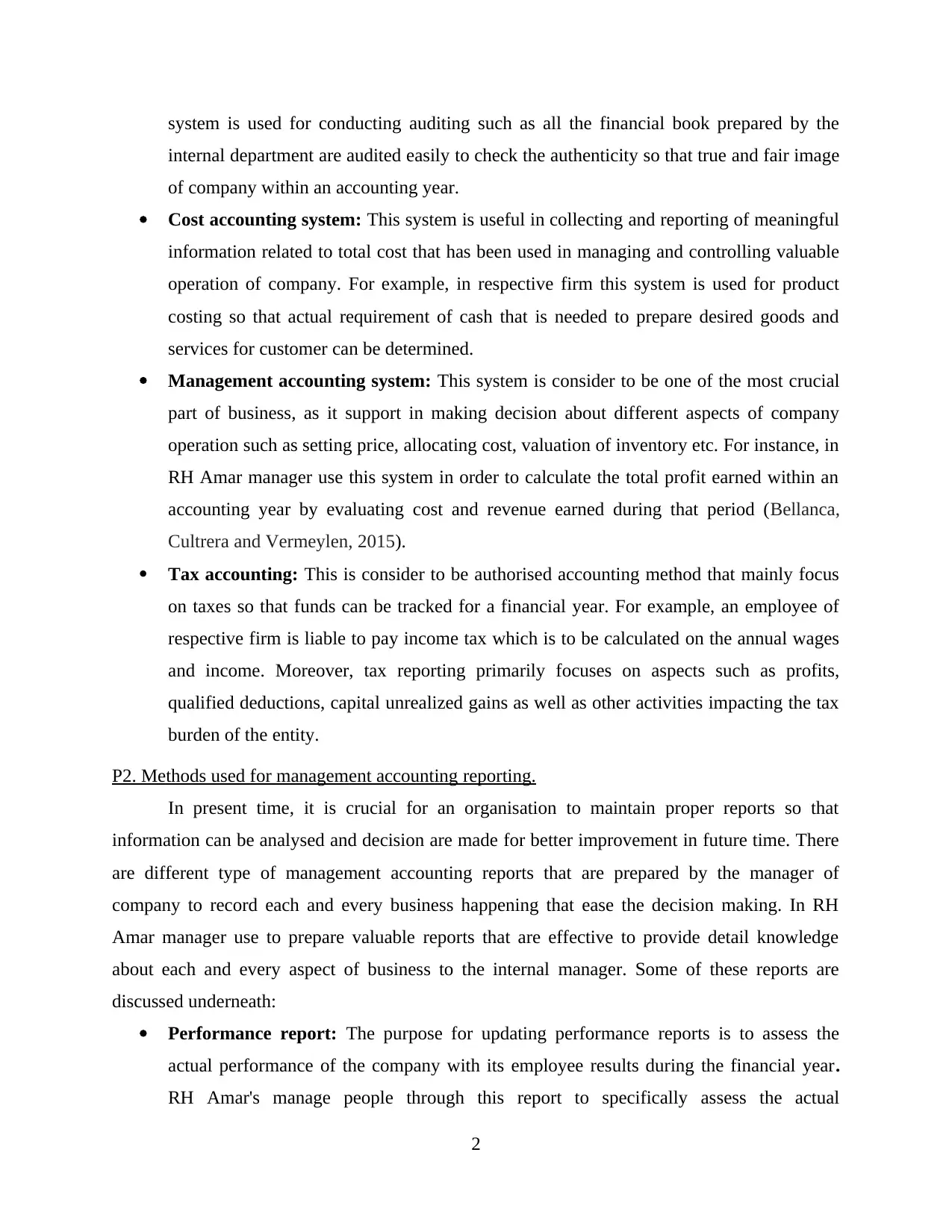
system is used for conducting auditing such as all the financial book prepared by the
internal department are audited easily to check the authenticity so that true and fair image
of company within an accounting year.
Cost accounting system: This system is useful in collecting and reporting of meaningful
information related to total cost that has been used in managing and controlling valuable
operation of company. For example, in respective firm this system is used for product
costing so that actual requirement of cash that is needed to prepare desired goods and
services for customer can be determined.
Management accounting system: This system is consider to be one of the most crucial
part of business, as it support in making decision about different aspects of company
operation such as setting price, allocating cost, valuation of inventory etc. For instance, in
RH Amar manager use this system in order to calculate the total profit earned within an
accounting year by evaluating cost and revenue earned during that period (Bellanca,
Cultrera and Vermeylen, 2015).
Tax accounting: This is consider to be authorised accounting method that mainly focus
on taxes so that funds can be tracked for a financial year. For example, an employee of
respective firm is liable to pay income tax which is to be calculated on the annual wages
and income. Moreover, tax reporting primarily focuses on aspects such as profits,
qualified deductions, capital unrealized gains as well as other activities impacting the tax
burden of the entity.
P2. Methods used for management accounting reporting.
In present time, it is crucial for an organisation to maintain proper reports so that
information can be analysed and decision are made for better improvement in future time. There
are different type of management accounting reports that are prepared by the manager of
company to record each and every business happening that ease the decision making. In RH
Amar manager use to prepare valuable reports that are effective to provide detail knowledge
about each and every aspect of business to the internal manager. Some of these reports are
discussed underneath:
Performance report: The purpose for updating performance reports is to assess the
actual performance of the company with its employee results during the financial year.
RH Amar's manage people through this report to specifically assess the actual
2
internal department are audited easily to check the authenticity so that true and fair image
of company within an accounting year.
Cost accounting system: This system is useful in collecting and reporting of meaningful
information related to total cost that has been used in managing and controlling valuable
operation of company. For example, in respective firm this system is used for product
costing so that actual requirement of cash that is needed to prepare desired goods and
services for customer can be determined.
Management accounting system: This system is consider to be one of the most crucial
part of business, as it support in making decision about different aspects of company
operation such as setting price, allocating cost, valuation of inventory etc. For instance, in
RH Amar manager use this system in order to calculate the total profit earned within an
accounting year by evaluating cost and revenue earned during that period (Bellanca,
Cultrera and Vermeylen, 2015).
Tax accounting: This is consider to be authorised accounting method that mainly focus
on taxes so that funds can be tracked for a financial year. For example, an employee of
respective firm is liable to pay income tax which is to be calculated on the annual wages
and income. Moreover, tax reporting primarily focuses on aspects such as profits,
qualified deductions, capital unrealized gains as well as other activities impacting the tax
burden of the entity.
P2. Methods used for management accounting reporting.
In present time, it is crucial for an organisation to maintain proper reports so that
information can be analysed and decision are made for better improvement in future time. There
are different type of management accounting reports that are prepared by the manager of
company to record each and every business happening that ease the decision making. In RH
Amar manager use to prepare valuable reports that are effective to provide detail knowledge
about each and every aspect of business to the internal manager. Some of these reports are
discussed underneath:
Performance report: The purpose for updating performance reports is to assess the
actual performance of the company with its employee results during the financial year.
RH Amar's manage people through this report to specifically assess the actual
2
Paraphrase This Document
Need a fresh take? Get an instant paraphrase of this document with our AI Paraphraser
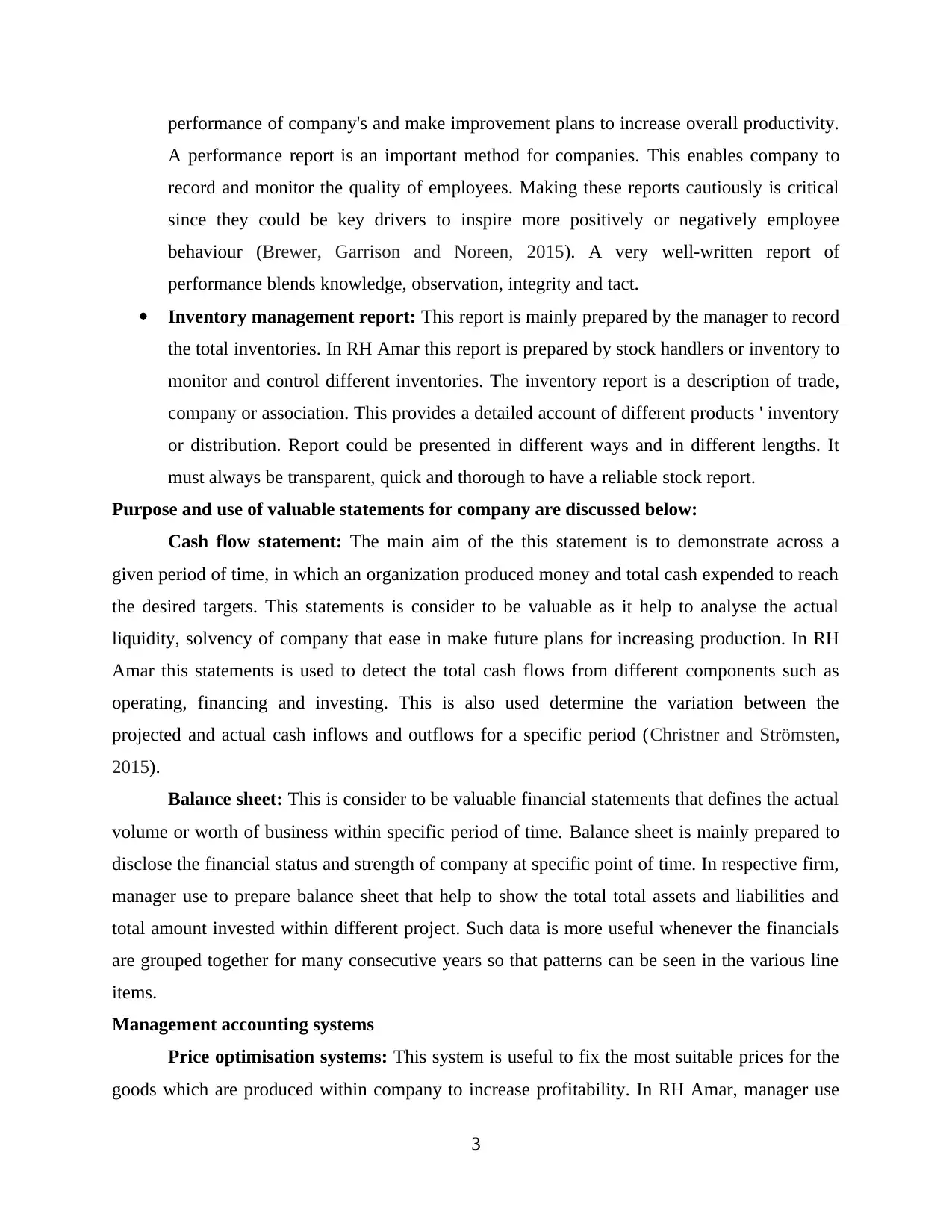
performance of company's and make improvement plans to increase overall productivity.
A performance report is an important method for companies. This enables company to
record and monitor the quality of employees. Making these reports cautiously is critical
since they could be key drivers to inspire more positively or negatively employee
behaviour (Brewer, Garrison and Noreen, 2015). A very well-written report of
performance blends knowledge, observation, integrity and tact.
Inventory management report: This report is mainly prepared by the manager to record
the total inventories. In RH Amar this report is prepared by stock handlers or inventory to
monitor and control different inventories. The inventory report is a description of trade,
company or association. This provides a detailed account of different products ' inventory
or distribution. Report could be presented in different ways and in different lengths. It
must always be transparent, quick and thorough to have a reliable stock report.
Purpose and use of valuable statements for company are discussed below:
Cash flow statement: The main aim of the this statement is to demonstrate across a
given period of time, in which an organization produced money and total cash expended to reach
the desired targets. This statements is consider to be valuable as it help to analyse the actual
liquidity, solvency of company that ease in make future plans for increasing production. In RH
Amar this statements is used to detect the total cash flows from different components such as
operating, financing and investing. This is also used determine the variation between the
projected and actual cash inflows and outflows for a specific period (Christner and Strömsten,
2015).
Balance sheet: This is consider to be valuable financial statements that defines the actual
volume or worth of business within specific period of time. Balance sheet is mainly prepared to
disclose the financial status and strength of company at specific point of time. In respective firm,
manager use to prepare balance sheet that help to show the total total assets and liabilities and
total amount invested within different project. Such data is more useful whenever the financials
are grouped together for many consecutive years so that patterns can be seen in the various line
items.
Management accounting systems
Price optimisation systems: This system is useful to fix the most suitable prices for the
goods which are produced within company to increase profitability. In RH Amar, manager use
3
A performance report is an important method for companies. This enables company to
record and monitor the quality of employees. Making these reports cautiously is critical
since they could be key drivers to inspire more positively or negatively employee
behaviour (Brewer, Garrison and Noreen, 2015). A very well-written report of
performance blends knowledge, observation, integrity and tact.
Inventory management report: This report is mainly prepared by the manager to record
the total inventories. In RH Amar this report is prepared by stock handlers or inventory to
monitor and control different inventories. The inventory report is a description of trade,
company or association. This provides a detailed account of different products ' inventory
or distribution. Report could be presented in different ways and in different lengths. It
must always be transparent, quick and thorough to have a reliable stock report.
Purpose and use of valuable statements for company are discussed below:
Cash flow statement: The main aim of the this statement is to demonstrate across a
given period of time, in which an organization produced money and total cash expended to reach
the desired targets. This statements is consider to be valuable as it help to analyse the actual
liquidity, solvency of company that ease in make future plans for increasing production. In RH
Amar this statements is used to detect the total cash flows from different components such as
operating, financing and investing. This is also used determine the variation between the
projected and actual cash inflows and outflows for a specific period (Christner and Strömsten,
2015).
Balance sheet: This is consider to be valuable financial statements that defines the actual
volume or worth of business within specific period of time. Balance sheet is mainly prepared to
disclose the financial status and strength of company at specific point of time. In respective firm,
manager use to prepare balance sheet that help to show the total total assets and liabilities and
total amount invested within different project. Such data is more useful whenever the financials
are grouped together for many consecutive years so that patterns can be seen in the various line
items.
Management accounting systems
Price optimisation systems: This system is useful to fix the most suitable prices for the
goods which are produced within company to increase profitability. In RH Amar, manager use
3
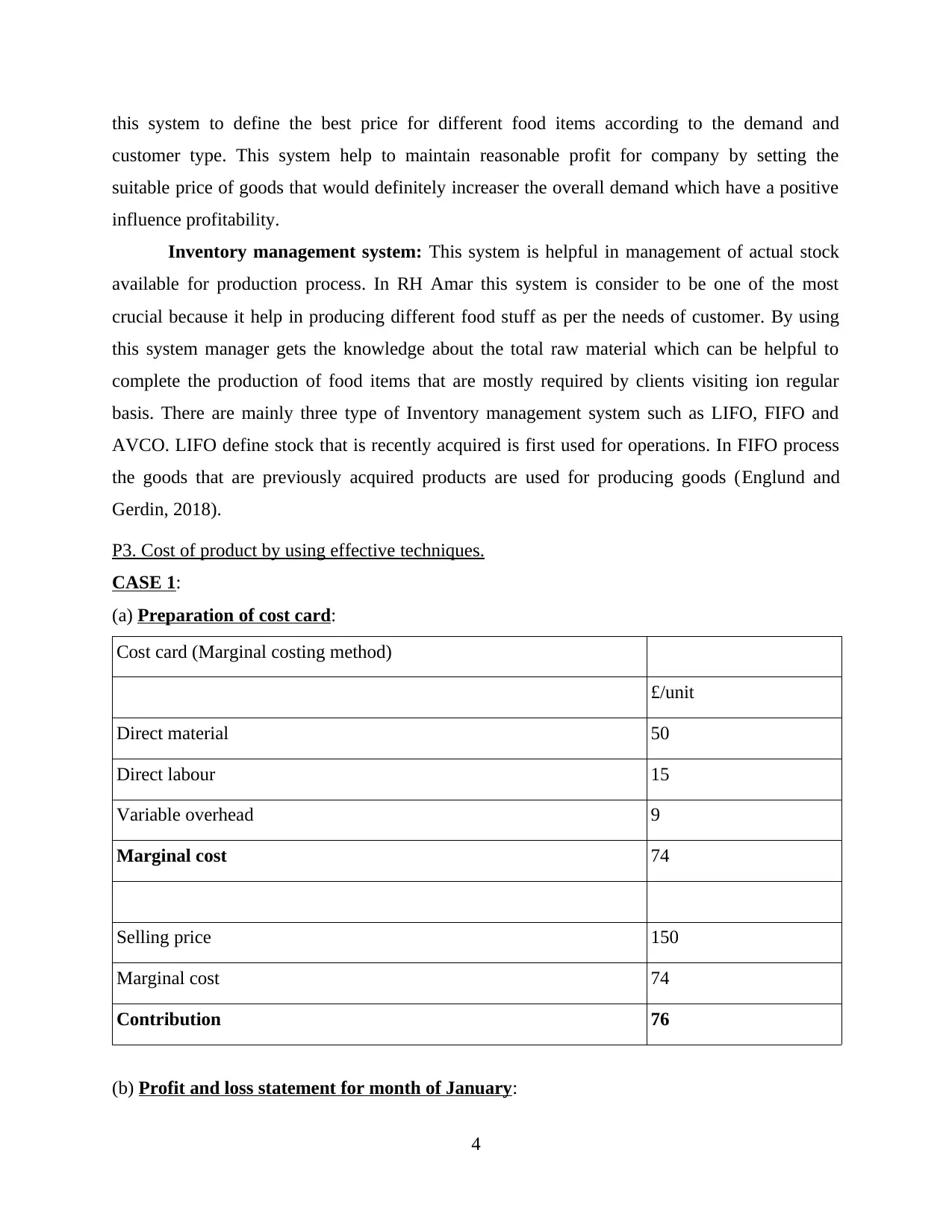
this system to define the best price for different food items according to the demand and
customer type. This system help to maintain reasonable profit for company by setting the
suitable price of goods that would definitely increaser the overall demand which have a positive
influence profitability.
Inventory management system: This system is helpful in management of actual stock
available for production process. In RH Amar this system is consider to be one of the most
crucial because it help in producing different food stuff as per the needs of customer. By using
this system manager gets the knowledge about the total raw material which can be helpful to
complete the production of food items that are mostly required by clients visiting ion regular
basis. There are mainly three type of Inventory management system such as LIFO, FIFO and
AVCO. LIFO define stock that is recently acquired is first used for operations. In FIFO process
the goods that are previously acquired products are used for producing goods (Englund and
Gerdin, 2018).
P3. Cost of product by using effective techniques.
CASE 1:
(a) Preparation of cost card:
Cost card (Marginal costing method)
£/unit
Direct material 50
Direct labour 15
Variable overhead 9
Marginal cost 74
Selling price 150
Marginal cost 74
Contribution 76
(b) Profit and loss statement for month of January:
4
customer type. This system help to maintain reasonable profit for company by setting the
suitable price of goods that would definitely increaser the overall demand which have a positive
influence profitability.
Inventory management system: This system is helpful in management of actual stock
available for production process. In RH Amar this system is consider to be one of the most
crucial because it help in producing different food stuff as per the needs of customer. By using
this system manager gets the knowledge about the total raw material which can be helpful to
complete the production of food items that are mostly required by clients visiting ion regular
basis. There are mainly three type of Inventory management system such as LIFO, FIFO and
AVCO. LIFO define stock that is recently acquired is first used for operations. In FIFO process
the goods that are previously acquired products are used for producing goods (Englund and
Gerdin, 2018).
P3. Cost of product by using effective techniques.
CASE 1:
(a) Preparation of cost card:
Cost card (Marginal costing method)
£/unit
Direct material 50
Direct labour 15
Variable overhead 9
Marginal cost 74
Selling price 150
Marginal cost 74
Contribution 76
(b) Profit and loss statement for month of January:
4
⊘ This is a preview!⊘
Do you want full access?
Subscribe today to unlock all pages.

Trusted by 1+ million students worldwide
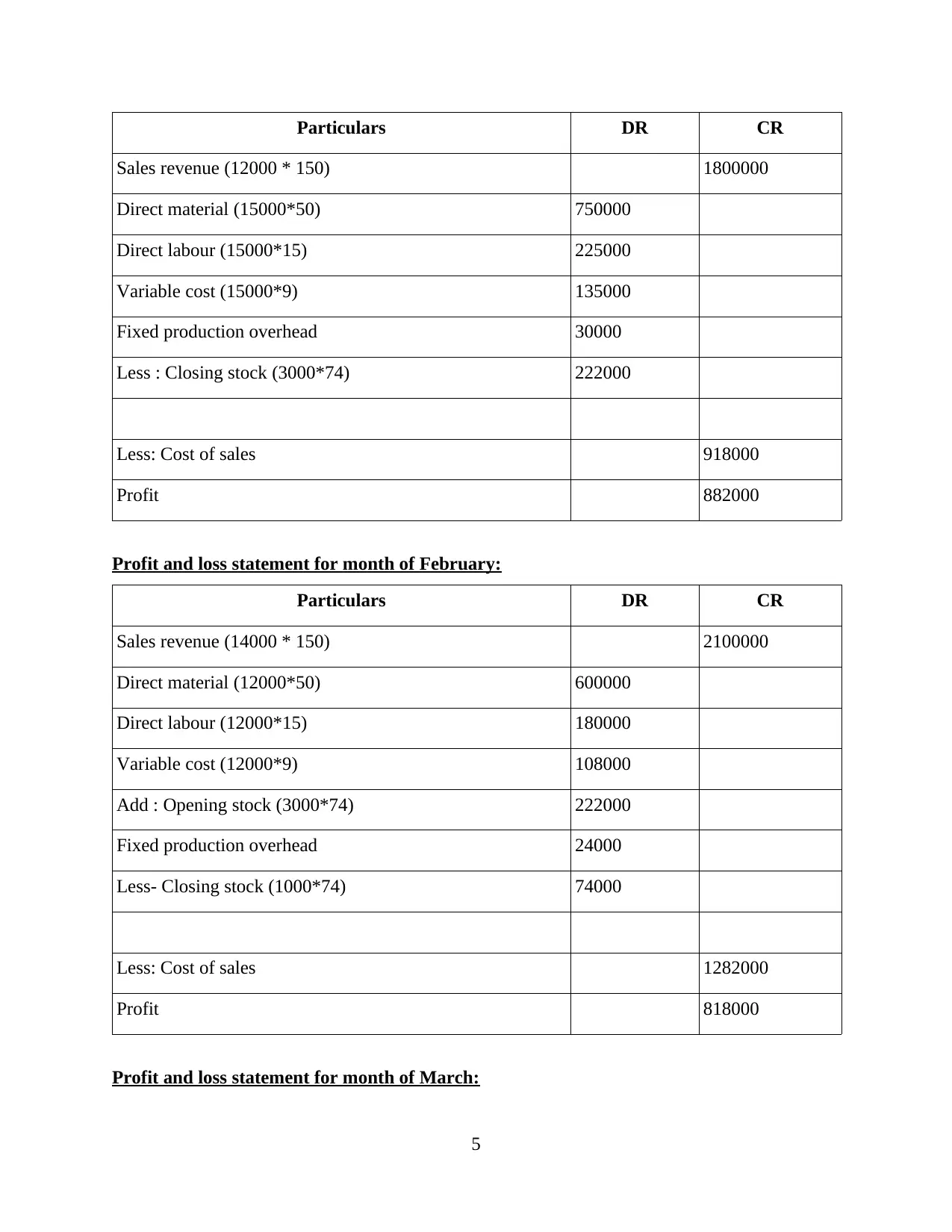
Particulars DR CR
Sales revenue (12000 * 150) 1800000
Direct material (15000*50) 750000
Direct labour (15000*15) 225000
Variable cost (15000*9) 135000
Fixed production overhead 30000
Less : Closing stock (3000*74) 222000
Less: Cost of sales 918000
Profit 882000
Profit and loss statement for month of February:
Particulars DR CR
Sales revenue (14000 * 150) 2100000
Direct material (12000*50) 600000
Direct labour (12000*15) 180000
Variable cost (12000*9) 108000
Add : Opening stock (3000*74) 222000
Fixed production overhead 24000
Less- Closing stock (1000*74) 74000
Less: Cost of sales 1282000
Profit 818000
Profit and loss statement for month of March:
5
Sales revenue (12000 * 150) 1800000
Direct material (15000*50) 750000
Direct labour (15000*15) 225000
Variable cost (15000*9) 135000
Fixed production overhead 30000
Less : Closing stock (3000*74) 222000
Less: Cost of sales 918000
Profit 882000
Profit and loss statement for month of February:
Particulars DR CR
Sales revenue (14000 * 150) 2100000
Direct material (12000*50) 600000
Direct labour (12000*15) 180000
Variable cost (12000*9) 108000
Add : Opening stock (3000*74) 222000
Fixed production overhead 24000
Less- Closing stock (1000*74) 74000
Less: Cost of sales 1282000
Profit 818000
Profit and loss statement for month of March:
5
Paraphrase This Document
Need a fresh take? Get an instant paraphrase of this document with our AI Paraphraser

Particulars DR CR
Sales revenue (11000 * 150) 1650000
Direct material (10000*50) 500000
Direct labour (10000*15) 150000
Variable cost (10000*9) 90000
Add : Opening stock (1000*74) 74000
Fixed production overhead 20000
Less: Cost of sales 834000
Profit 816000
Case 2
(a) Cost card for January:
Cost card (Absorption costing)
£/unit
Direct material (50*15000) 750000
Direct labour (15*15000) 225000
Production overhead (fixed + variable) [7*15000] 105000
Total cost 1080000
Absorption cost of product 1080000 / 15000= 72
Selling price 150
Less- Total cost 72
6
Sales revenue (11000 * 150) 1650000
Direct material (10000*50) 500000
Direct labour (10000*15) 150000
Variable cost (10000*9) 90000
Add : Opening stock (1000*74) 74000
Fixed production overhead 20000
Less: Cost of sales 834000
Profit 816000
Case 2
(a) Cost card for January:
Cost card (Absorption costing)
£/unit
Direct material (50*15000) 750000
Direct labour (15*15000) 225000
Production overhead (fixed + variable) [7*15000] 105000
Total cost 1080000
Absorption cost of product 1080000 / 15000= 72
Selling price 150
Less- Total cost 72
6

Profit 78
(b) Profit and loss account for month of January:
Particulars DR CR
Sales revenue (12000*150) 1800000
Variable cost:
Direct material (15000*50) 750000
Direct labour (15000*15) 225000
Less- Closing stock (3000*74) 222000
Fixed production cost (30000+3000) 33000
Less: cost of sales 786000
Profit 1014000
Profit and loss account for month of February:
Particulars DR CR
Sales revenue (14000*150) 2100000
Variable cost:
Direct material (12000*50) 600000
Direct labour (12000*15) 180000
Add- Opening stock (3000*74) 222000
Less- Closing stock (1000*74) 74000
Fixed production cost (24000+3000) 27000
Less: cost of sales 955000
7
(b) Profit and loss account for month of January:
Particulars DR CR
Sales revenue (12000*150) 1800000
Variable cost:
Direct material (15000*50) 750000
Direct labour (15000*15) 225000
Less- Closing stock (3000*74) 222000
Fixed production cost (30000+3000) 33000
Less: cost of sales 786000
Profit 1014000
Profit and loss account for month of February:
Particulars DR CR
Sales revenue (14000*150) 2100000
Variable cost:
Direct material (12000*50) 600000
Direct labour (12000*15) 180000
Add- Opening stock (3000*74) 222000
Less- Closing stock (1000*74) 74000
Fixed production cost (24000+3000) 27000
Less: cost of sales 955000
7
⊘ This is a preview!⊘
Do you want full access?
Subscribe today to unlock all pages.

Trusted by 1+ million students worldwide
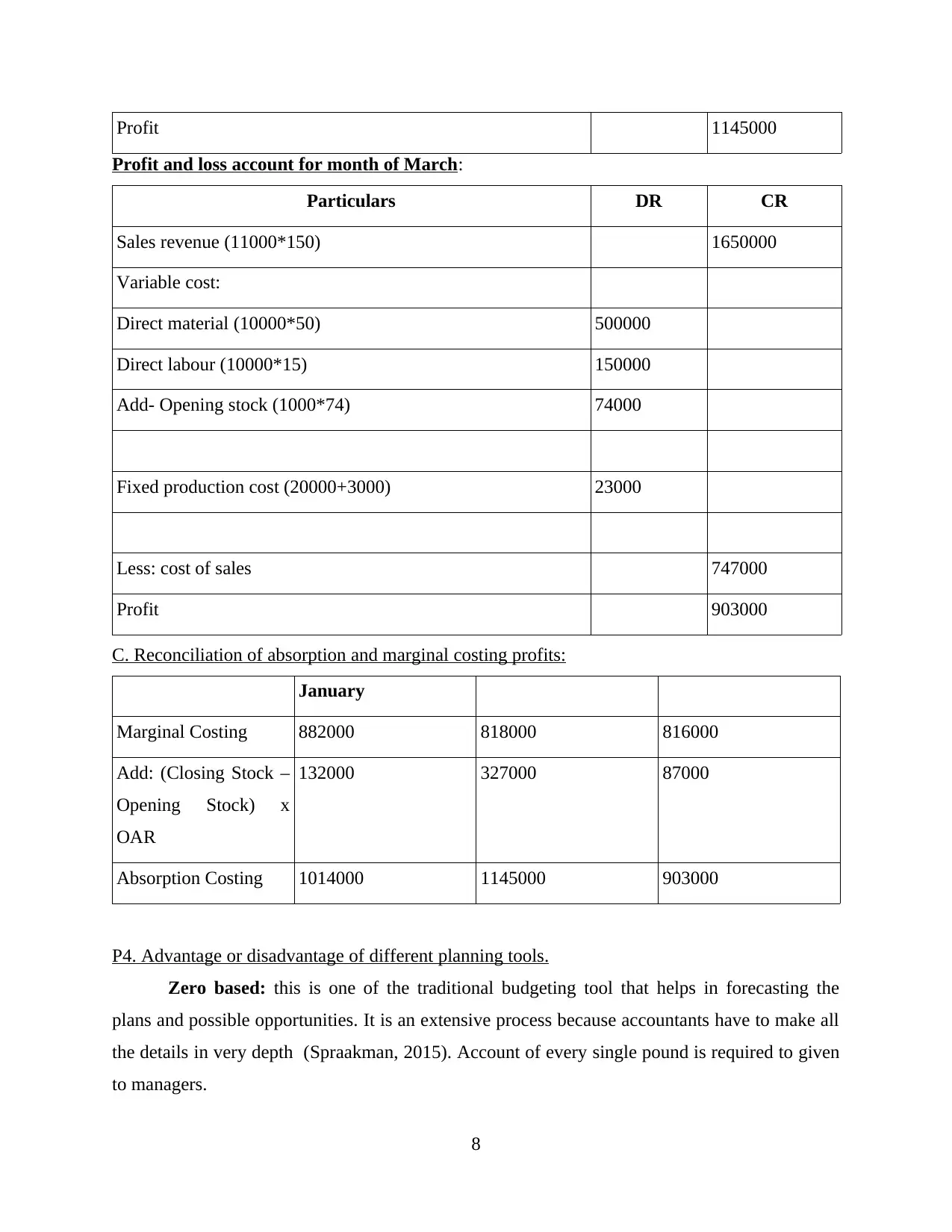
Profit 1145000
Profit and loss account for month of March:
Particulars DR CR
Sales revenue (11000*150) 1650000
Variable cost:
Direct material (10000*50) 500000
Direct labour (10000*15) 150000
Add- Opening stock (1000*74) 74000
Fixed production cost (20000+3000) 23000
Less: cost of sales 747000
Profit 903000
C. Reconciliation of absorption and marginal costing profits:
January
Marginal Costing 882000 818000 816000
Add: (Closing Stock –
Opening Stock) x
OAR
132000 327000 87000
Absorption Costing 1014000 1145000 903000
P4. Advantage or disadvantage of different planning tools.
Zero based: this is one of the traditional budgeting tool that helps in forecasting the
plans and possible opportunities. It is an extensive process because accountants have to make all
the details in very depth (Spraakman, 2015). Account of every single pound is required to given
to managers.
8
Profit and loss account for month of March:
Particulars DR CR
Sales revenue (11000*150) 1650000
Variable cost:
Direct material (10000*50) 500000
Direct labour (10000*15) 150000
Add- Opening stock (1000*74) 74000
Fixed production cost (20000+3000) 23000
Less: cost of sales 747000
Profit 903000
C. Reconciliation of absorption and marginal costing profits:
January
Marginal Costing 882000 818000 816000
Add: (Closing Stock –
Opening Stock) x
OAR
132000 327000 87000
Absorption Costing 1014000 1145000 903000
P4. Advantage or disadvantage of different planning tools.
Zero based: this is one of the traditional budgeting tool that helps in forecasting the
plans and possible opportunities. It is an extensive process because accountants have to make all
the details in very depth (Spraakman, 2015). Account of every single pound is required to given
to managers.
8
Paraphrase This Document
Need a fresh take? Get an instant paraphrase of this document with our AI Paraphraser
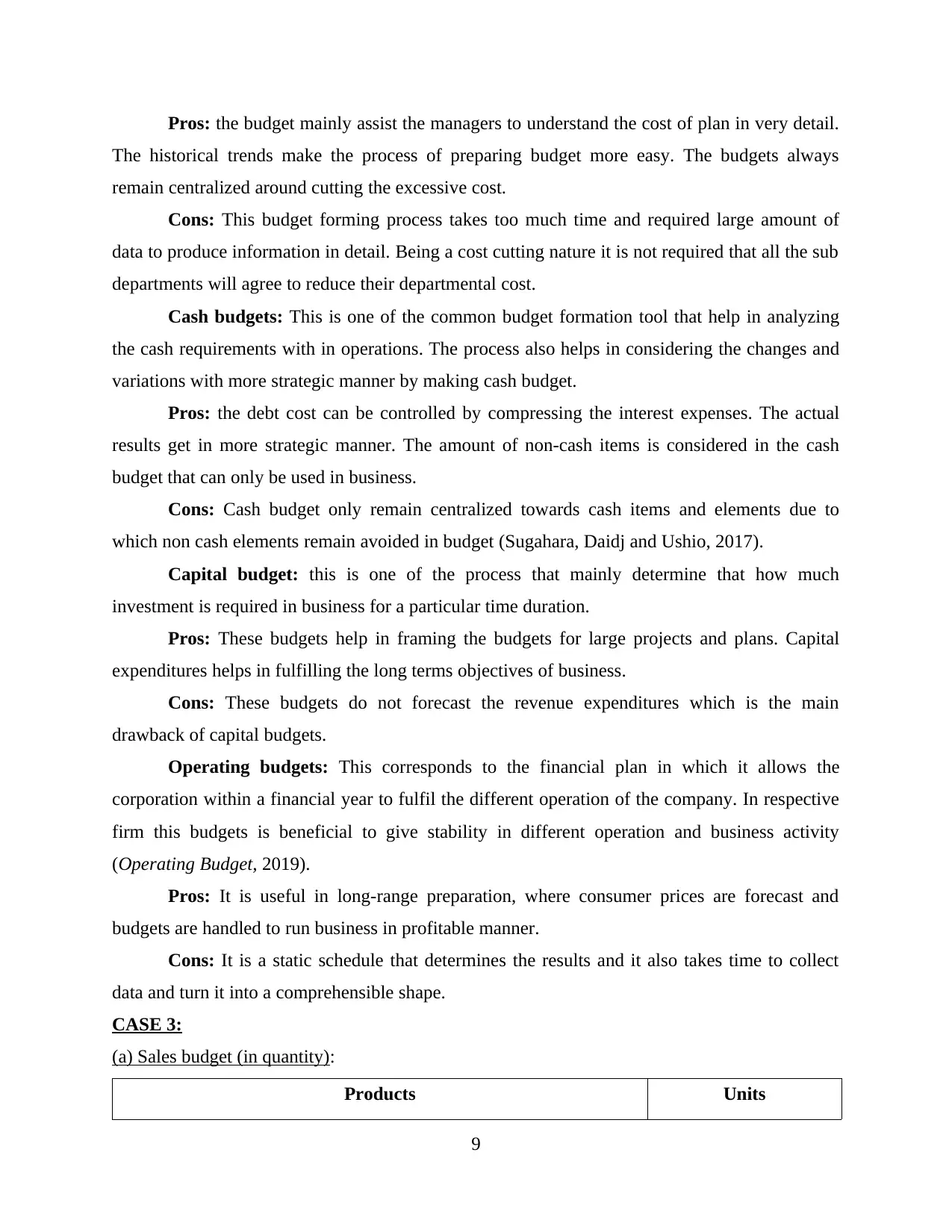
Pros: the budget mainly assist the managers to understand the cost of plan in very detail.
The historical trends make the process of preparing budget more easy. The budgets always
remain centralized around cutting the excessive cost.
Cons: This budget forming process takes too much time and required large amount of
data to produce information in detail. Being a cost cutting nature it is not required that all the sub
departments will agree to reduce their departmental cost.
Cash budgets: This is one of the common budget formation tool that help in analyzing
the cash requirements with in operations. The process also helps in considering the changes and
variations with more strategic manner by making cash budget.
Pros: the debt cost can be controlled by compressing the interest expenses. The actual
results get in more strategic manner. The amount of non-cash items is considered in the cash
budget that can only be used in business.
Cons: Cash budget only remain centralized towards cash items and elements due to
which non cash elements remain avoided in budget (Sugahara, Daidj and Ushio, 2017).
Capital budget: this is one of the process that mainly determine that how much
investment is required in business for a particular time duration.
Pros: These budgets help in framing the budgets for large projects and plans. Capital
expenditures helps in fulfilling the long terms objectives of business.
Cons: These budgets do not forecast the revenue expenditures which is the main
drawback of capital budgets.
Operating budgets: This corresponds to the financial plan in which it allows the
corporation within a financial year to fulfil the different operation of the company. In respective
firm this budgets is beneficial to give stability in different operation and business activity
(Operating Budget, 2019).
Pros: It is useful in long-range preparation, where consumer prices are forecast and
budgets are handled to run business in profitable manner.
Cons: It is a static schedule that determines the results and it also takes time to collect
data and turn it into a comprehensible shape.
CASE 3:
(a) Sales budget (in quantity):
Products Units
9
The historical trends make the process of preparing budget more easy. The budgets always
remain centralized around cutting the excessive cost.
Cons: This budget forming process takes too much time and required large amount of
data to produce information in detail. Being a cost cutting nature it is not required that all the sub
departments will agree to reduce their departmental cost.
Cash budgets: This is one of the common budget formation tool that help in analyzing
the cash requirements with in operations. The process also helps in considering the changes and
variations with more strategic manner by making cash budget.
Pros: the debt cost can be controlled by compressing the interest expenses. The actual
results get in more strategic manner. The amount of non-cash items is considered in the cash
budget that can only be used in business.
Cons: Cash budget only remain centralized towards cash items and elements due to
which non cash elements remain avoided in budget (Sugahara, Daidj and Ushio, 2017).
Capital budget: this is one of the process that mainly determine that how much
investment is required in business for a particular time duration.
Pros: These budgets help in framing the budgets for large projects and plans. Capital
expenditures helps in fulfilling the long terms objectives of business.
Cons: These budgets do not forecast the revenue expenditures which is the main
drawback of capital budgets.
Operating budgets: This corresponds to the financial plan in which it allows the
corporation within a financial year to fulfil the different operation of the company. In respective
firm this budgets is beneficial to give stability in different operation and business activity
(Operating Budget, 2019).
Pros: It is useful in long-range preparation, where consumer prices are forecast and
budgets are handled to run business in profitable manner.
Cons: It is a static schedule that determines the results and it also takes time to collect
data and turn it into a comprehensible shape.
CASE 3:
(a) Sales budget (in quantity):
Products Units
9

Sofas 50
Beds 40
Chairs 100
Total 190
Sales budget (in value):
Products Amount
Sofas 7500
Beds 5200
Chairs 10000
Total 22700
(b) Production budget in units:
Products
Particulars Sofas Beds Chairs
Budgeted sales 50 40 100
Add- Desired closing stock 600 1000 800
Total needs 650 1040 900
Less- Opening stock 500 800 700
Required production 150 240 200
(c) Material purchase budget:
Particulars Wood Varnish
Raw material 12000 5280
Less : Opening stock 11000 10000
Add- Closing stock 8000 9000
Material usage 9000 4280
10
Beds 40
Chairs 100
Total 190
Sales budget (in value):
Products Amount
Sofas 7500
Beds 5200
Chairs 10000
Total 22700
(b) Production budget in units:
Products
Particulars Sofas Beds Chairs
Budgeted sales 50 40 100
Add- Desired closing stock 600 1000 800
Total needs 650 1040 900
Less- Opening stock 500 800 700
Required production 150 240 200
(c) Material purchase budget:
Particulars Wood Varnish
Raw material 12000 5280
Less : Opening stock 11000 10000
Add- Closing stock 8000 9000
Material usage 9000 4280
10
⊘ This is a preview!⊘
Do you want full access?
Subscribe today to unlock all pages.

Trusted by 1+ million students worldwide
1 out of 16
Related Documents
Your All-in-One AI-Powered Toolkit for Academic Success.
+13062052269
info@desklib.com
Available 24*7 on WhatsApp / Email
![[object Object]](/_next/static/media/star-bottom.7253800d.svg)
Unlock your academic potential
Copyright © 2020–2025 A2Z Services. All Rights Reserved. Developed and managed by ZUCOL.





